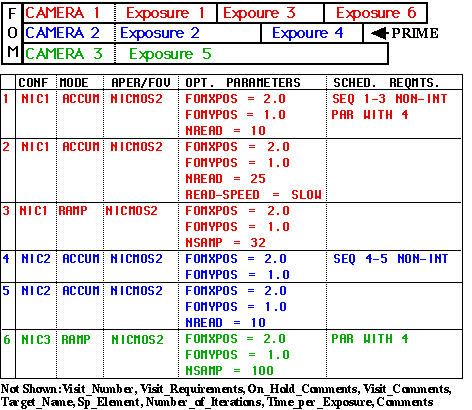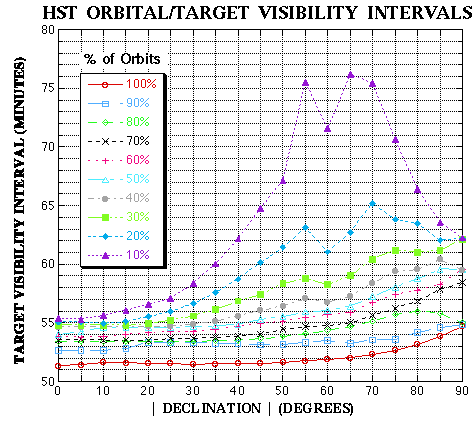NICMOS Detector Operations Overview
Detector Operations Modes
ACCUM
MULTIACCUM
RAMP
BRIGHT OBJECT
TARGET ACQUISITION
Loss-of-Lock Processing
Optional Parameters for Background Observations
Phase-2 Proposal/Visit Exposure Logsheet - Simplified Example
HST/System Resource Limitations
Defining Observations: Visits/Orbits/Exposures
Operating Mode: ACCUM (aka MIF - Multiple Initial and Final)
Instrument Configuration: NIC1/NIC2/NIC3
Simplest Observing Mode: Single Sampling Period, Single Image Array
Specific Use: Faint Targets, Long Integration Times - NREAD large,
High S/N Targets -NREAD small; minor CPU overhead
Specific Function: Reduces R/O Noise by Performing & Averaging Multiple
Initial and Final Read Outs.
(when read noise > dark current + photon noise)

Time_per_Exposure Optional Parameters
EXPTIME: > RS * NREAD NREAD = 1 - 25
RS ~ 0.27s for READ-RATE = FAST READ-RATE = FAST,SLOW
~ 2.70s for READ-RATE = SLOW BCK-OFFSET = FOM, SAM
May be any value, but preferably BCK-SCALE = # arc-sec
from indexed table for calibration FOMXPOS = # arc-sec
and memory efficiency. FOMYPOS = +/- # arc-sec
Operating Mode: MULTIACCUM
Instrument Configuration: NIC1/NIC2/NIC3
Exploits Non-Destructive FPA Read Out Capability
Specific Use: Large Dynamic Range, Ground Processing for CRs and Saturation
Specific Function: Multiple Images at Specific Times as Integration
Progresses

Time_per_Exposure Optional Parameters
EXPTIME: > RS * NREAD NSAMP = 1 - 25
RS ~ 0.27s for READ-RATE = FAST SAMP-TIMES(i) = # seconds
~ 2.70s for READ-RATE = SLOW READ-RATE = FAST,SLOW
BCK-OFFSET = FOM, SAM
BCK-SCALE = # arc-sec
FOMXPOS = # arc-sec
FOMYPOS = +/- # arc-sec
Operating Mode: RAMP
Instrument Configuration: NIC1/NIC2/NIC3
Exploits Non-Destructive FPA Read Out Capability
Specific Use: Large Dynamic Range, Uncertain Target Flux,
On-Board CR Elimination and Saturation Detection; CPU intensive
Specific Function: Slope Computation Reduces Data Volume, Provides Variance
and Sample Count Arrays

Time_per_Exposure Optional Parameters
EXPTIME: > (RS + OV) * NREAD NSAMP = 1 - 255
RS ~ 0.27s for READ-RATE = FAST CR-ELIMINATION (see table)
RS ~ 2.70s for READ-RATE = SLOW READ-RATE = FAST,SLOW
OV ~ 5s * number of detectors BCK-OFFSET = FOM, SAM
BCK-SCALE = # arc-sec
CR-ELIMINATION FOMXPOS = # arc-sec
NONE Disable CR-Elimination FOMYPOS = +/- # arc-sec
MARK Flag pixel as bad
RETAIN Use previous mean([[Delta]] signal), discontinue for that pixel
CONTINUE Reject individual sample if > threshold, continue processing
Operating Mode: BRIGHTOBJ
Instrument Configuration: NIC1/NIC2/NIC3
Specific Use: For Bright Targets Which Would Saturate FPAs in Other
Observing Modes with Shortest Integration Times
Specific Function: Reset/Read/Wait/Reset Each Pixel Sequentially in Each Quad

0.001024s < EXPTIME < 0.26112s
(Maximum Time Required = 4278.19s)
Operating Mode: ACQ
Instrument Configuration: NIC2
Specific Use: Autonomous Acquisition of Brightest Target in 128x128
pixel region (9.6") in Camera 2 for Coronographic Imaging
Specific Function: Results in Vehicle Offset Maneuver or FOM Motion to Place
Target Behind 0.3" Radius Occulting Spot
Internal Use of ACCUM Mode with NREAD = 1 to Obtain Acquisition Image
Brightest Object Located Using Target Centroiding with 3x3 Check Box
Target Location and Acquisition Precision to 1/4 Pixel Precision (18.75 mas)
Downlinks Initial Target Location ACCUM Images (Initial and Final)
Note: Performing "back-to-back" ACQ mode exposures would result in finding
the second brightest target in the field
Loss-of-Lock (TDF Down) Processing
ACCUM: After last Initial Read, Before first Final Read, Take
SINGLE Final Read Immediately. EXPTIME reduced,
R/O noise not reduced as planned.
MULTIACCUM: Read Out Current Sample Immediately. Reduced Sample
Duration. Remaining Planned Samples Not Read Out.
RAMP: Ignore Read when TDF down. Treat as CR Hit for ALL Pixels.
BRIGHTOBJ: No TDF Processing. Spatial Positioning of Post-TDF Down
Pixels Degraded.
ACQ: No TDF Processing. Probable Acquisition Failure on
TDF-Down.
Guiding Performance Since Re-Enabling of SAGA-2 (from 6 months of data):
* 5 true LOL events in ~2500 Fine-Lock Orbits (~1 event/500 orbits)
* Maximum LOL duration = 200 seconds, most < 1 minute
* Otherwise Level 1 guiding specification met: < 7 mas RMS jitter in FL
Note: Observations which are declared failures due Guide-Star Loss-of-Lock
may be repeated (by petitioning the TTRB) without GTO/GO time charged to the
failed observation.
Optional Parameters for Background Observations
Assumption: One or more scalable "standard patterns" of
field-offsets, to provide, a median-filtered sky background is sufficient for
most observations requiring background subtraction.
Geometry of Standard Background Patterns TDB, but are expected to
contain 16 or 25 pointings.
"Preferred" Background Offset Method is via SAM (S/C Small Angle Maneuver)
* FOM is left at MIQ Position (no change to PSF or degraded image quality)
* Preserves FOM lifetime (limited life item) for required use
* Small Offsets (< ~ 2') may be done on single GS pair w/o re-acquisition
* New Guiding scenario requested of GSAWG for large SAMs (FL / Gyro hand-off)
* Observer-Specified "Pattern" via POSITION TARGET Special Requirements
Sample (4x4) Background Offsets with Small SAMs

Background Offsetting via FOM (maximum displacement 26"):
* Maintains Fine Lock on Guide Stars - No Additional PCS Overhead
* REQUIRED for Parallel Programs (which do not control the S/C pointing)
* Observer-Specified "Pattern" via FOMXPOS, FOMYPOS Optional Parameters
Phase-2 Proposal Visit/Exposure Logsheet - Simplified Example

HST/SYSTEM Resource Limitations
Observational sequence definitions may be constrained by time or
data capacity limitations.
Maximum Number of Images in NICMOS Internal Data Store (IDS): 83
* This is total, NOT per camera.
* Images must be off-loaded to Science Tape Recorder (STR) Before IDS fills.
Science Tape Recorder Has Maximum Capacity of ~ 600 NICMOS Image Frames, but:
* STR is a resource shared with other SIs (1 4-CCD WFPC image ~ 40 NICMOS Images.
* Time-averaged data allocation for PRIME observations divided equally among all SIs.
* Parallel (i.e., survey or snap-shot) programs will have lesser priority than Primes.
* Nominal operations employ two-STR mode, one STR must be dumped before switching.
* Dump of FULL STR requires ~ 20 minutes.
* Downlink opportunities must be managed with uplink requirements.
NSSC-1 (HST SI Flight Computer) Has Only ~ 6K Words of Stored Command Memory
* Stored command memory is a shared resource with other SIs.
* Memory partition between Absolute and Relative Time processors is equally divided.
* NICMOS, STIS, and WFPC-2 primarily use ATP; FOC primarily uses RTCSs.
* Many short exposures will "use up" stored command memory quickly.
* Operational throughput of command uplink management must be increased.
NICMOS CPU is NO Speed Demon (16 MHz, 80386)
* iRMK operating system and task handling imposes some significant CPU bottlenecks.
* Some multi-camera detector operations can reduce efficiencies (notably RAMP mode)
What's The Bottom Line?
* Greatest impact for Parallel (e.g., survey) programs.
* Define EFSW Macros for executing such programs.
* Consider benefits of reduced data volume offered by RAMP mode when appropriate
* Understand timing ramifications of multi-camera operations (notably RAMP mode)
Defining Observations: Visits/Orbits/Exposures
A New Method of Defining Observations Was Adopted by
STScI for HST Cycle 5.
* Driven by allocation of GO time in "Orbits" rather than S/C time.
* Replacement of RPSS with RPS-2 + Orbit Visualization Tool.
Vehicle Slews to Targets are NOT Considered Part of the
Observation.
ORBIT = Min (Time between Start of Guide Star Acquisition and Earth Occultation,
Time Between S/C Ascending Node Crossings {~96 minutes}
Note: All Orbits are NOT Created Equal

VISIT = Time Interval While HST Attitude is Maintained by PCS for One Target
* Visit may be one or more orbits (GS Reacqs contained within one Visit).
* Vehicle Small Angle Maneuvers permitted within a Visit.
EXPOSURE = Sequence of SI events driven from a single Exposure Logsheet Line
* e.g., FOM Move, Filter Selection, Detector Operation.
* Multiple image frames may result from one Exposure (e.g., MULTIACCUM)
All Three NICMOS Cameras May Be Operated Simultaneously
* Simultaneous operations for a gven program must be defined for the Visit.
* Specification of simultaneous operations currently via RPS-2 scheduling requirements.
* STScI is developing a GUI to simplify defining simultaneous operations.
* Parallel operations with an unused camera may be non-intrusively "Attached" to Primes.
(Due to CPU loading some multi-modal attachments may be restricted)
Return to NICMOS UofA Home Page home page.